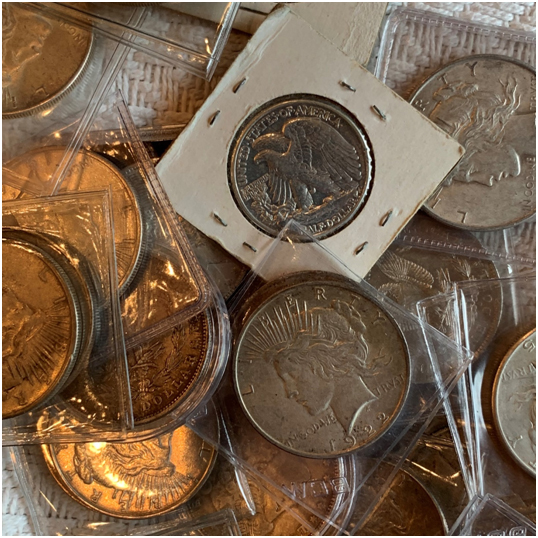Here Is How You Can Learn Coin Condition Grading for Silver Coins in Three Simple Steps

There is even a 70 point scale on which coins are rated. However, there isn’t an exact science behind the method. It can be taken as a coin guide, instead of a method. There is a bit of bias and subjectivity involved especially when you deal with local coin dealers. Minor details can have negative or positive influences on a coin’s value. Certain collectors can even prefer one coin over the other. Toning is a perfect example. Some dealers will pay less if a coin is toned while others pay a premium for vivid natural toning. Especially on Toned Morgan Dollars, strong examples often are called Monster toned Morgan’s and some have sold for up to $20,000 for a coin that if it wasn’t toned would have been worth $500.00
How Does Coin Condition Grading Work?
Coin Condition grading divides coins in to three basic categories. The first is ‘circulated coins’, the second is ‘About Uncirculated coins’ (AU), and the third is ‘uncirculated coins’ (Mint State or MS). Then there are Proof coins, these were never made for circulation and only minted for collectors.
These three divisions form the basis of the 70 point grading scale.
What is the 70 Point Coin Grading Scale?
Officially called the Sheldon Grading Scale, it basically ranks coins on their condition and thus helps determine their relative value. These coins were originally graded by using adjectives; Fair, Good, Excellent, Uncirculated and Gem, but that proved insufficient. For one, the definitions of these terms varied widely by coin collector.
Eventually, a 70 point scale was decided upon. It ranged from Poor (P-1) to Perfect Mint State (MS-70). Below are the basic definitions for these grades:
P-1: Poor. This grade is for coins that are barely identifiable. Most markers have been erased due to erosion, wear and tear.
FR-2: Fair. The coin is almost smooth, but not so damaged as to label it poor. It is still identifiable.
G-4: Good. Inscriptions are merged in places, but the coin is still identifiable. However, major features mostly destroyed.
VG-8: Very Good. It’s worn, but major design elements are obvious. Central details are absent.
F-12: Fine. Design elements stand out, but are clearly worn. Fully separated rims from the field.
VF-20: Very Fine. Finer details persist. All letters and the motto are generally visible.
EF-40: Extremely Fine. Lightly worn coin, on which all significant devices are clear and bold. Light wear is noticeable.
AU-50: About Uncirculated. High points of the coin’s design show wear. These coins are considered acceptable.
AU-58: Very Choice About Uncirculated. Very slight hints of wear visible and no abundance of heavy contact marks. Mint luster of the coin is still noticeable.
MS-60: Mint State Basal State. Subdued luster is visible on the coin with noticeable contact marks and hairlines.
MS-63: Mint State Acceptable. Uncirculated coin with contact marks and nicks. Luster has been slightly impaired, but the strike is average to weak. Cartwheels of light can be seen from the original coins luster.
MS-65: Mint State Choice. Strong mint luster, very few contact marks and strike above average on this coin. These are considered GEM coins as they represent the high end.
MS-68: Mint State Premium Quality. This coin has perfect luster. The strike is sharp. Looks like it was just made. Very rare grade.
MS-69: Mist State Almost Perfect. There is perfect luster and very few flaws only visible under ‘8x magnification’ on the coin. There are no planchet or strike marks to speak of on this coin. Extremely rare.
MS-70: Mint State Perfect. This is the best coin that you can hope to sell. There are no flaws visible even under a microscope and the strike is very sharp. It has its original luster, and has incredible appeal to the eye. Extremely rare and not often found.
Grading Circulated Coins
This is the easiest way to start learning silver coin grading.
Begin by finding an excellent light source. This could be a 100-watt bulb lamp, or something similar. Just remember that it has to illuminate the coin fully. You’ll also need a magnifier capable of 5x to 8x magnifications. Anything higher isn’t usually used in coin grading. Anything lower is too weak to see the important details worn out in the coin.
Then you have to determine which division your coin falls in to. If it’s uncirculated, then it’ll be graded differently than an About Uncirculated or circulated coin. If it’s a circulated coin, it’ll be judged differently.
The final step is to determine where your coin fits on the scale. Remember that the numbers on the scale don’t correspond to equivalent damage between scale points. For example the difference between EF-40 and Ef-20 isn’t the same as between MS-60 and EF-40.
A coin which is graded at Ef-40 has lost just 5-10% of its detail. However an EF-20 coin has lost nearly 60%.
Moreover, the only way you’ll get good at the intricacies of coin grading is if you keep practicing. This is an art, not an exact science. Hence, you’ll need more than a few tries to become an expert.
Don’t forget to look at the rims of the coins as the entire coin is graded.
Step 1: Identify the year and type of the coin
Step 2: Identify the mint mark of the coin. No mint mark means it’s a P coin minted in Philadelphia. Other mint marks to look for are D: Denver, S: San Francisco, O: New Orleans, W: West Point
Step 3: Identify the Grad of the Coin using the Sheldon scale described above.
If you are looking to sell your gold or silver coins, or looking for who buy old coins visit: www.cashforcoins.net Looking to sell entire collections or estate coins use our custom offer form: https://www.cashforcoins.net/get-a-quote/
« « 25 Most Valuable US Morgan Dollars You Can Sell on the Open Market Today | Use These Tips to Find out if Your Online Coin Dealer Is a Fraud » »
Categories:
Tags Cloud:
coin guide local coin dealers silver coin grading



